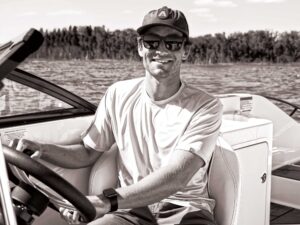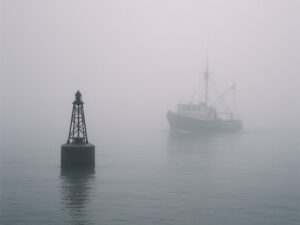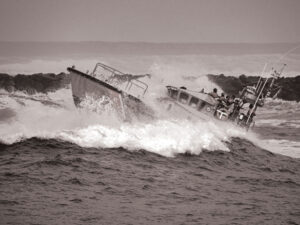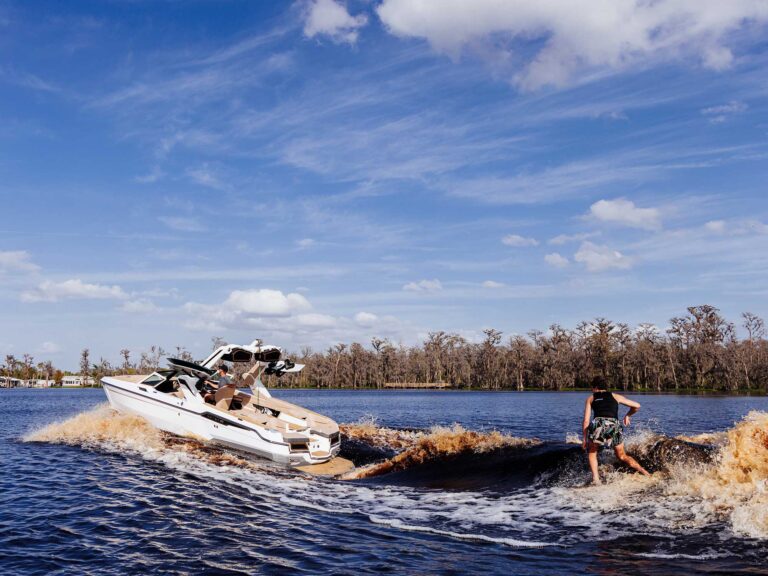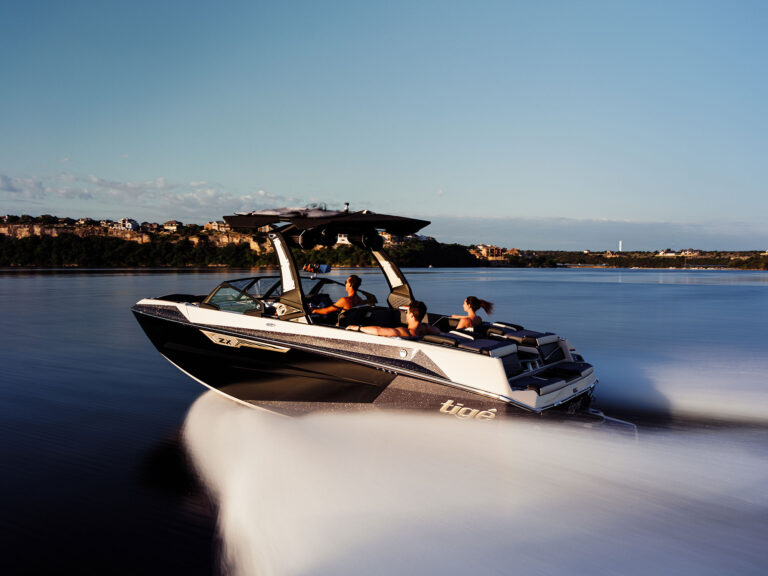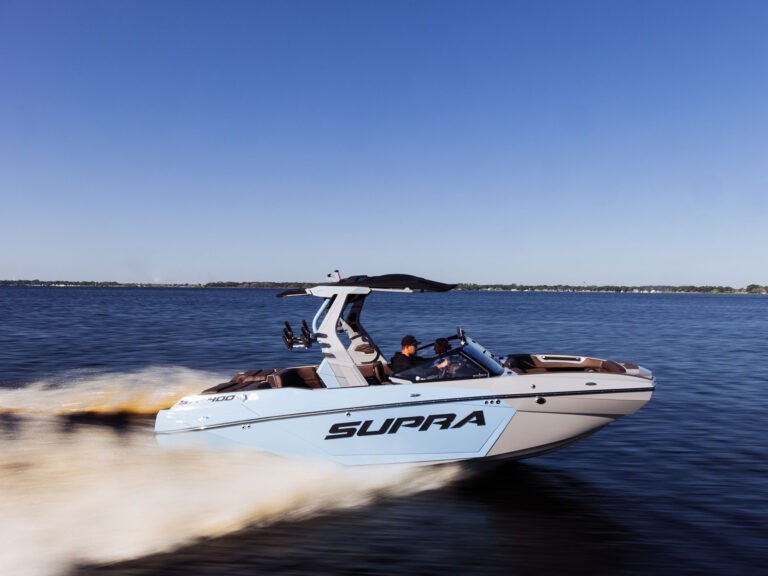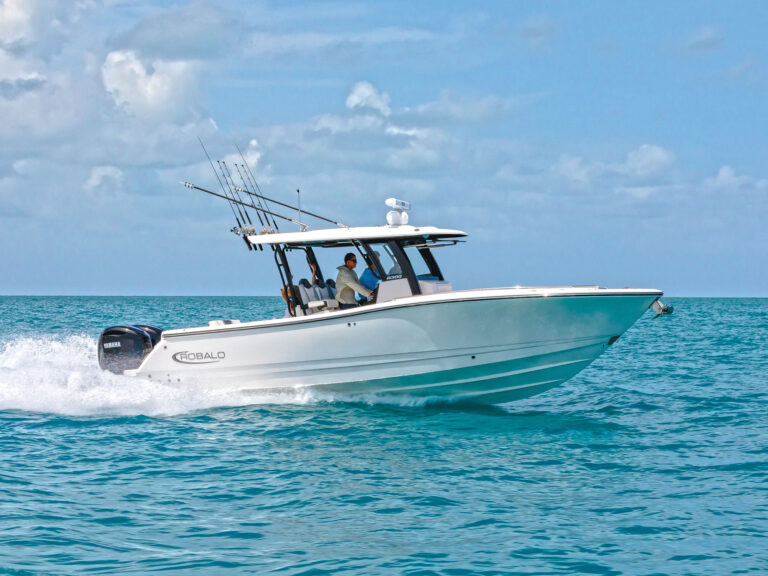One minute we’re four guys enjoying a day aboard a classic 1968 Bertram 31. The next minute, we’re three. I’m at the helm when Jeff shouts over the engine noise, “Man overboard!” I pull back the throttles and turn my head to the cockpit. Jeff is staring and pointing at Pat, who’s bobbing in the water about 60 yards behind the boat. What now? Thoughts of how to retrieve Pat flash through my head. Do the right thing and we’ll quickly have Pat back in the boat. Do something wrong and …
Well, this time I’ll just get lectured by Cmdr. Chris Gasiorek, and he’s pretty even-tempered. He’s the one putting me through a training exercise at the United States Merchant Marine Academy (USMMA) in Kings Point, New York. The USMMA puts its graduates into key positions on military and commercial vessels all over the world. “Our goal is to teach them to drive ships,” Gasiorek says, “but you can’t drive a ship unless you can drive a Whaler.” That’s why I’m here. Not to simply drive the Bertram, but to be led into a minefield of emergencies, just as the cadets are, during a day of real-world drilling.
Man Overboard
Jeff is second-year cadet Jeff Musselman. He and third-year cadet Pete Kaple, also aboard, maintain and run this 31 Bertram, Sirina, as part of their training under Gasiorek’s watch at the Yocum Sailing Center. Pat is Patrick Minnick, a 17-year-old first-year “plebe” assigned to Sirina. Guess who gets picked to be the overboard “volunteer”?
Thing is, I have no idea what’s coming until it happens. So I step to the helm and put the twin Yanmar diesels in gear. Without warning, Pat, donning a life jacket, leaps off the stern. After I pull back the throttles, Pete points out my first mistake. “The first thing you do is appoint a spotter,” he says. “Usually it’s the guy who calls ‘man overboard.’” This time the spotter should be Jeff. Once Jeff locates the man in the water, his only job is to keep his eyes locked on and his arm pointed at him. Throttling back comes second. That’s me.
I turn the boat and head toward Pat in a straight line, my second mistake. “Always circle back into the weather,” Pete says. approach a man overboard from the leeward side; if you come from windward, the boat will drift faster than the person and could get pushed on top of him. I don’t think Pat would appreciate that.
We approach Pat and get ready to bring him back aboard. We have calm seas, so Pete tells me to kill the engines so the props aren’t spinning. In rough seas, though, you want to keep power to maintain control.
I grab the heaving line to throw it to Pat. Normally the captain would never leave the helm; he would assign a third person to throw the line. But I’m the one getting put to the test so I hop back to throw it. The line has a heavy floating ball at the end rather than a cushion or throw ring because it’s easier to throw the weightier ball into the wind. I coil the line and make a two-handed heave to Pat and begin pulling him in. Gasiorek, observing from another boat, throws a curve ball.
“What if he’s unconscious?” he asks. That’s the only time you put someone else in the water. Assign someone to jump overboard and put a life jacket on the victim. Depending on the severity of injuries, you can pull him up by the life jacket or fashion a harness to aid in bringing him over the gunwale. Jeff and I grab Pat by the jacket shoulders and haul him in, no worse for wear.

Smoke on the Water
Pat is drying off , no doubt wishing he were a second-year cadet, when Jeff throws another problem my way. “There’s smoke coming from the port engine compartment!” he yells to me. “What do you do?” I kill the engines, the right thing to do, and duck belowdecks to find the extinguisher. Wrong. I should stay at the helm and assign someone else on board to prepare the fire extinguisher. Then I should use my VHF to alert the Coast Guard of our situation on Channel 16.
I walk back to open the port hatch. Jeff reminds me not to open it all the way. “Crack the hatch to put the nozzle in,” Jeff says, “and empty the extinguisher.” Empty it even if the fire looks to be out. One of the biggest problems with engine compartment fires is reflash, so you can’t over-extinguish.
If the fire extinguishers aren’t working, have the crew don life jackets and stand by with buckets of water. On a twin-engine boat, use the good engine to point the bow into the wind so the flames and smoke don’t go down into the cabin or around the helm.
We put out the imaginary fire (which came courtesy of a smoke machine) and use the working engine to head to the nearest safe harbor, with me at the helm awaiting the next fiasco.
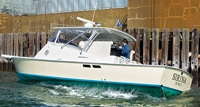
Powerless and Adrift
We’re limping home when Pete hits me with another disaster. We lose all power and are now adrift. The VHF is dead too. I realize I’ve committed a cardinal sin of boating; I don’t have a backup. Always carry a handheld VHF and GPS aboard so you can call for help and pinpoint your location should the units installed at the helm lose power. With a working radio, call for help. “If you’re in a shipping lane, get on Channel 13 and notify other captains that you’re adrift in traffic,” Jeff says.
“If you’re drifting into trouble,” Pete says, “drop the hook.” Your anchor is your first line of defense against drifting into danger, such as the surf line or rocks or jetties. “A lot of people don’t even think to do that,” Gasiorek adds.
If it’s too rough or you’re too deep to drop the anchor, a sea anchor is the next best thing. A sea anchor is a large cloth bag or parachute that helps slow your drift. If you don’t have one, you can rig a makeshift sea anchor by running spare lines through the eyelets of your boat’s canvas. Cleat it off the bow to keep the boat pointed into the waves and out of a dangerous beam sea situation.
We don’t have one on board, so I’m tempted to use Pat the Plebe as a human sea anchor, but no one else thinks that’s such a good idea.
Taking on Water
A man overboard, an engine fire and adrift at sea … what else could go wrong? Plenty.
“You’re taking on water,” Jeff tells me. Water, like fire, tends to make boaters do one thing: panic. But it’s my responsibility to solve the problem. “Go through a checklist of the most common reasons to take on water,” Jeff says. First is forgetting to put in a plug. Second is an open or cracked seacock, or a leaky underwater fitting. Third is an exhaust elbow breached below the waterline, or a hole in the hull.
If it’s the plug or a failed seacock, find something to stick into the hole to stop it. Some offshore cruisers fashion wooden “bungs” to plug holes in case of an emergency — or shape plugs from sticky wax-ring toilet seals from the plumbing supply store. If it’s a hole in the hull, use whatever means necessary to plug it: seat cushions, spare life jackets, towels, shirts — anything to stem the incoming water to a rate slower than the bilge pump can handle.
And always remember this: “The best bilge pump in the world,” Gasiorek says, “is a scared guy with a bucket.”
Running Aground
We’ve miraculously survived all of these calamities and are heading back to the North Dock at the Yocum Sailing Center when another situation befalls us. We run aground. I immediately throw the throttles in reverse and try to back off the imaginary “sandbar.” Wrong move.
“First shut down the engines and make sure no one in your crew is hurt,” Pete says. Then check the bilge to see if you’re taking on water. If no one’s hurt and the boat looks OK, assess how you’re going to get off. If you’ve hit hard and dug in, you might have to wait for the tide to rise and lift you.
Since we’re not really stuck, I power up, put the throttles in reverse and start heading for home. “Don’t just get up and go,” jeff says. “Start slowly and feel for vibrations.” If something feels or sounds amiss, shut down. There could be a problem with the shafts, props or engine, and you’ll do more harm than good.
For scholarship’s sake, we determine that one engine is too damaged to use and start limping home with the other.
Casualty Docking
We make it back to the dock, but not without more angst. I approach the marina bow-first and try to line up with the dock. With the throttle in forward, I find myself zigzagging all over the place. “With twin-screw boats, you have much more control with one engine going astern,” Gasiorek says. Line up your boat with the dock by “steering” the boat with short bursts in reverse, and put it in forward only for momentum. But don’t give it too much juice. “The famous motto,” Gasiorek says, “is ‘Go slow like a pro and fast like an ass.'”
In short order, I master the “ass” part. Pete jumps in and takes the helm before I turn our training session into a real-life crisis. He lines up the boat and pulls it in without incident. I get ready to jump to the dock when Pete hands me a PFD. “Every time we do lines, we wear life jackets,” he says, “regardless of the situation.” I also violated another cardinal rule: never do something before the captain tells you to. Any time he gives an order, repeat it back so he knows you heard him.
I step on the dock and back into reality. Training day is over and we all survived. I’m not ready to take charge of an oceangoing tanker any time soon, but I’ll feel a whole lot better the next time I run a Whaler.

